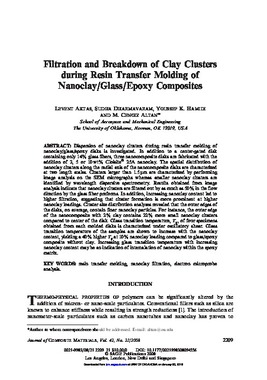| dc.contributor.author | Levent Aktas | |
| dc.contributor.author | Sudha Dharmavaram | |
| dc.contributor.author | Youssef K. Hamidi | |
| dc.contributor.author | M. Cengiz Altan | |
| dc.date.accessioned | 2016-01-14T19:52:42Z | |
| dc.date.accessioned | 2016-03-30T15:34:50Z | |
| dc.date.available | 2016-01-14T19:52:42Z | |
| dc.date.available | 2016-03-30T15:34:50Z | |
| dc.date.issued | 2008-11-01 | |
| dc.identifier.citation | Aktas, L., Dharmavaram, S., Hamidi, Y. K., & Cengiz Altan, M. (2008). Filtration and Breakdown of Clay Clusters during Resin Transfer Molding of Nanoclay/Glass/Epoxy Composites. Journal of Composite Materials, 42(21), 2209-2229. doi: 10.1177/0021998308094556 | en_US |
| dc.identifier.uri | https://hdl.handle.net/11244/24857 | |
| dc.description.abstract | Dispersion of nanoclay clusters during resin transfer molding of nanoclay/glass/epoxy disks is investigated. In addition to a center-gated disk containing only 14% glass fibers, three nanocomposite disks are fabricated with the addition of 2, 5 or 10 wt% Cloisite® 25A nanoclay. The spatial distribution of nanoclay clusters along the radial axis of the nanocomposite disks are characterized at two length scales. Clusters larger than 1.5 μm are characterized by performing image analysis on the SEM micrographs whereas smaller nanoclay clusters are identified by wavelength dispersive spectrometry. Results obtained from image analysis indicate that nanoclay clusters are filtered out by as much as 50% in the flow direction by the glass fiber preforms. In addition, increasing nanoclay content led to higher filtration, suggesting that cluster formation is more prominent at higher nanoclay loadings. Cluster size distribution analyses revealed that the outer edges of the disks, on average, contain finer nanoclay particles. For instance, the outer edge of the nanocomposite with 2% clay contains 22% more small nanoclay clusters compared to center of the disk. Glass transition temperature, Tg, of four specimens obtained from each molded disks is characterized under oscillatory shear. Glass transition temperature of the samples are shown to increase with the nanoclay content, yielding a 40% higher Tg at 10% nanoclay loading compared to glass/epoxy composite without clay. Increasing glass transition temperature with increasing nanoclay content may be an indication of intercalation of nanoclay within the epoxy matrix. | en_US |
| dc.language.iso | en_US | en_US |
| dc.publisher | Journal of Composite Materials | |
| dc.subject | resin transfer molding | en_US |
| dc.subject | nanoclay filtration | en_US |
| dc.subject | electron microprobe analysis. | en_US |
| dc.title | Filtration and Breakdown of Clay Clusters during Resin Transfer Molding of Nanoclay/Glass/Epoxy Composites | en_US |
| dc.type | Research Article | en_US |
| dc.description.peerreview | Yes | en_US |
| dc.description.peerreviewnotes | https://us.sagepub.com/en-us/nam/manuscript-submission-guidelines | en_US |
| dc.identifier.doi | 10.1177/0021998308094556 | en_US |
| dc.rights.requestable | false | en_US |
